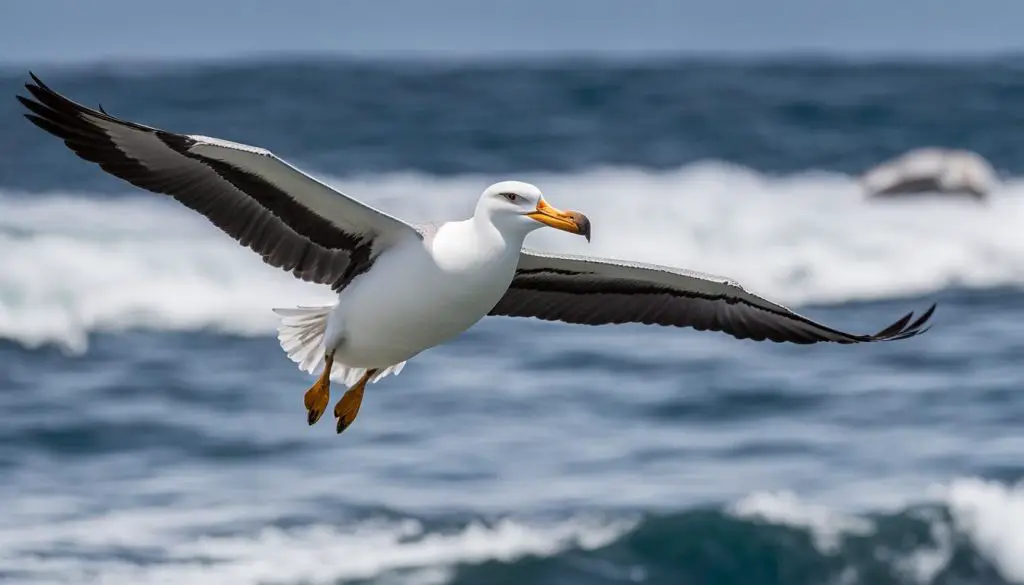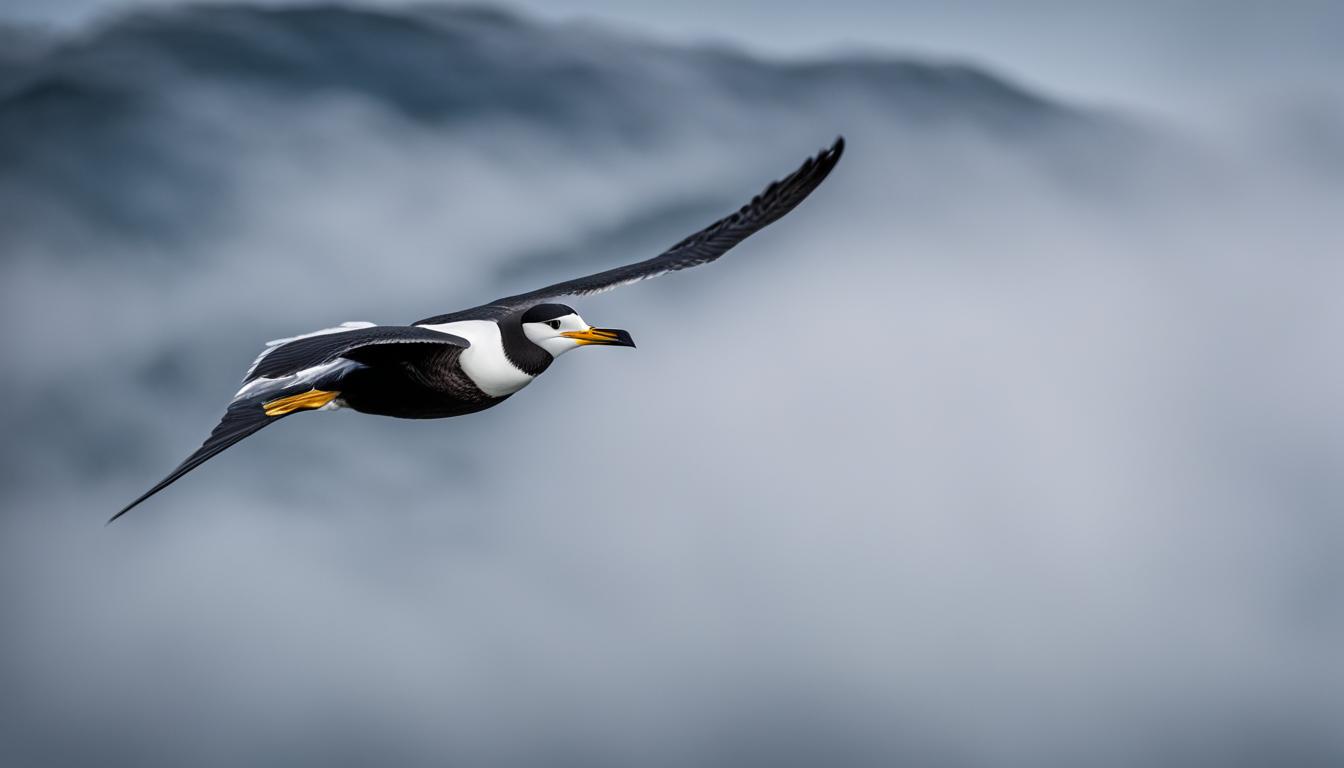In sailor folklore, there is a belief that a certain marine bird is a symbol of good luck. This bird is none other than the albatross, which has been regarded by sailors as a positive omen for centuries. According to Samuel Taylor Coleridge’s poem “The Rime of the Ancient Mariner,” the albatross was considered a sign of good luck when it followed a ship at sea. However, if the albatross was harmed or killed, it was believed to bring bad luck upon the ship and its crew.
Contents
- 1 The Symbolic Meaning of the Albatross in Sailor Folklore
- 2 The Origins of Seafaring Superstitions about Marine Birds
- 3 The Albatross in Literature and Art
- 4 Albatross in Popular Culture
- 5 The Difference Between an Albatross and a Seagull
- 6 Conclusion
- 7 FAQ
- 7.1 What is the significance of the albatross in sailor folklore?
- 7.2 Why is the albatross considered a lucky bird for seafarers?
- 7.3 What is the origin of the albatross superstition?
- 7.4 How has the albatross been depicted in literature and art?
- 7.5 How does the albatross feature in popular culture?
- 7.6 What is the spiritual and symbolic meaning of the albatross?
- 7.7 What is the difference between an albatross and a seagull?
- 8 Source Links
Key Takeaways:
- The albatross is believed to be a lucky bird for sailors and is considered a powerful symbol of luck and protection.
- In sailor folklore, the albatross is seen as a guardian spirit that watches over ships and their crews, guiding them through treacherous waters.
- The superstition surrounding the albatross can be traced back to ancient seafaring traditions and myths, where certain birds were believed to bring fortune or misfortune.
- The albatross has made its mark in literature and art, particularly through its depiction in Samuel Taylor Coleridge’s poem “The Rime of the Ancient Mariner.”
- The albatross has found its way into popular culture, making appearances in films, music, and musicals.
The Symbolic Meaning of the Albatross in Sailor Folklore
In sailor folklore, the albatross holds a significant place as a symbol of luck and protection for those venturing at sea. Revered for its large wingspan and effortless soaring abilities, the albatross is believed to bring favorable winds, calm waters, and safe passage to sailors on their maritime journeys. It is seen as a guardian spirit, watching over ships and their crews, guiding them through treacherous waters and leading them towards their destination.
The albatross represents not only luck but also freedom and adventure, reflecting the spirit of exploration and the thrill of sailing the open seas. Its presence brings hope and reassurance to seafarers, reminding them of their interconnectedness with the natural world and the serendipitous forces that shape their maritime experiences.
Throughout history, the albatross has been celebrated for its role in sailor folklore, being depicted in literature and art as a powerful symbol. Its embodiment of both fortune and misfortune has captured the imagination of writers, artists, and sailors alike, leaving an indelible mark on our collective consciousness.
One notable literary portrayal of the albatross can be found in Samuel Taylor Coleridge’s poem “The Rime of the Ancient Mariner.” The poem chronicles the misfortunes that befall a mariner after he shoots an albatross, symbolizing the burden of guilt and the consequences of disrupting the delicate balance of nature. This narrative further solidified the albatross as a symbol of both luck and remorse, serving as a cautionary tale for those who dare to harm this sacred creature of the sea.
Superstitions About Marine Birds
In addition to the albatross, various other marine birds have been associated with superstitions and beliefs surrounding luck and seafaring. Seagulls, for example, are often seen as omens of favorable weather conditions by sailors. Their presence near a ship is interpreted as a sign of calm waters and a smooth journey ahead. Similarly, petrels and shearwaters are regarded as indicators of stormy weather, warning seafarers of impending rough seas and turbulent winds.
| Marine Bird | Superstition |
|---|---|
| Albatross | Symbol of luck and protection |
| Seagull | Omen of favorable weather |
| Petrel | Indicator of stormy weather |
| Shearwater | Warning of rough seas |
These marine birds, each with their unique characteristics and behaviors, have woven themselves into the fabric of maritime lore, deepening the connection between sailors and the natural world they navigate.
The Origins of Seafaring Superstitions about Marine Birds
In sailor folklore, the belief in lucky marine birds has been passed down through generations of seafarers. These mythical beliefs surround certain species of birds that are perceived to bring luck and protection to sailors on their voyages. As sailors relied heavily on favorable weather conditions and safe passage, the presence of these birds was seen as a positive omen, ensuring a successful journey.
The origins of these superstitions can be traced back to ancient seafaring traditions and myths. Many cultures believed that birds had mystical powers and could influence the outcome of a voyage. They saw marine birds, such as the albatross, as emissaries from the spirit world, capable of bringing fortune or misfortune to sailors.
Over time, the association between marine birds and luck became ingrained in sailor folklore. The albatross, with its impressive wingspan and ability to navigate the winds and currents of the ocean, became particularly revered. Sailors would eagerly seek the presence of these birds as a sign of safe passage, while harming or killing them was believed to bring about bad luck and curses upon the ship and its crew.
The Albatross in Literature and Art
The albatross has had a significant presence in both literature and art, becoming a symbol that captures the imagination of many artists and writers. Its symbolic meaning and association with luck and protection have led to its portrayal in various artistic forms, allowing for a deeper exploration of its significance in human culture.
Samuel Taylor Coleridge’s poem “The Rime of the Ancient Mariner” is perhaps one of the most notable literary works that incorporates the albatross. In the poem, the albatross is depicted as a positive omen of good luck when it follows the ship, but its death brings about a curse and guilt upon the mariner. This portrayal has solidified the albatross as a symbol of burden and guilt, with the image of an albatross around one’s neck representing a heavy psychological weight.
“Ah! well a-day! what evil looks
Had I from old and young!
Instead of the cross, the Albatross
About my neck was hung.”
Beyond Coleridge’s poem, the albatross has also made appearances in other literary works and genres. It has been used metaphorically to represent freedom, adventure, and the unpredictability of the sea. Through these portrayals, the albatross becomes a powerful symbol that adds depth and nuance to the themes explored in literature.
The Albatross in Visual Art
In the realm of visual art, the albatross has been captured in various paintings and sculptures, often reflecting its majestic presence and mythical associations. Artists have sought to convey the sense of awe and reverence that the albatross inspires through their depictions.
One notable example is the painting “The Wounded Albatross” by Charles William Heathcote. This artwork portrays an injured albatross surrounded by stormy seas, symbolizing the vulnerability and resilience of the creature. The painting serves as a poignant reminder of the delicate balance between humanity and the natural world.

Through literature and art, the albatross continues to captivate our imagination and provoke contemplation on the themes of luck, protection, guilt, and the complexities of human nature. Its symbolism and significance remain timeless, leaving an enduring mark on our cultural consciousness.
| Book | Author | Description |
|---|---|---|
| “The Rime of the Ancient Mariner” | Samuel Taylor Coleridge | A poem that showcases the albatross as a symbol of luck and burden. |
| “Moby-Dick” | Herman Melville | The albatross is referenced as a symbol of freedom and the vastness of the sea. |
| “The Voyage of the Beagle” | Charles Darwin | Darwin describes the majestic flight of the albatross during his exploration. |
Albatross in Popular Culture
Over the years, the albatross has become a prominent figure in popular culture, making appearances in various forms of media. Films, music, and musicals have all incorporated the symbolism of the albatross to evoke themes of luck, misfortune, and adventure.
In films like “Master and Commander: The Far Side of the World” and “Serenity,” the albatross is used as a symbol of luck or misfortune depending on its fate. These movies showcase the impact that the presence or absence of an albatross can have on the characters’ journeys and outcomes.
“The albatross, with its air of mystery and symbolism, brings an element of intrigue to these stories,” says film critic Jane Thompson. “It represents the unpredictable nature of the sea and the fortunes that await those who venture into its depths.”
In the world of music, bands like Iron Maiden and Fleetwood Mac have referenced the albatross in their songs, using it as a metaphor for various themes such as freedom, burdens, and the unknown. Musical theater productions have also embraced the symbolism of the albatross, incorporating it into their narratives. In “Thoroughly Modern Millie” and “Kinky Boots,” the albatross serves as a symbol that drives the plot and impacts the characters’ journeys.
| Film | Albatross Reference |
|---|---|
| Master and Commander: The Far Side of the World | The presence of an albatross signifies good luck and safe passage. |
| Serenity | The absence of an albatross brings misfortune and danger. |
“The use of the albatross in music and theater adds depth to the storytelling and allows audiences to ponder the significance of the bird’s symbolism,” comments theater critic Mark Johnson. “It creates a sense of anticipation and intrigue, as audiences wonder how the albatross will impact the characters’ journeys.”
These cultural references in popular media further highlight the albatross’s enduring presence and its role as a symbol in the collective consciousness. Whether it signifies luck, misfortune, freedom, or adventure, the albatross continues to captivate our imagination and remind us of the mysteries and symbolism associated with the open seas.

| Symbolism | Meaning |
|---|---|
| Grace | The albatross represents grace and elegance, reminding us to move through life with poise and beauty. |
| Endurance | Just as the albatross can fly long distances without tiring, it symbolizes our ability to persevere through challenges and hardships. |
| Loyalty | The albatross is a symbol of loyalty, urging us to stay true to ourselves and those we care about. |
| Freedom | The albatross embodies freedom and encourages us to embrace our own freedom of expression and individuality. |
The Difference Between an Albatross and a Seagull
While seagulls are acrobatic birds commonly found near the sea, garbage tips, or fast food outlets, the albatross is a much larger seabird known for its ability to soar over the ocean with minimal wing movement. The albatross spends a majority of its life either at sea or near the sea, feeding on marine creatures. Unlike seagulls, which are more opportunistic feeders, albatrosses have a more specialized diet and are known for their long-distance migrations.
Seagulls are often seen scavenging for food and are adapted to thrive in various environments, including coastal areas, inland water bodies, and even urban areas. They are known for their distinctive cry and their ability to fly with ease, maneuvering through the air to catch prey or find sources of food. Seagulls are also known for their opportunistic behavior, taking advantage of human presence and discarded food.
On the other hand, the albatross is a majestic bird with an impressive wingspan that allows it to glide for hours without flapping its wings. They are known for their effortless flight and are built for long ocean flights. Albatrosses primarily feed on fish, squid, and other marine organisms, often covering vast distances in search of food. They have developed a unique way of foraging, using their keen eyesight to spot prey from above.

In summary, while both seagulls and albatrosses are seabirds, there are distinct differences between the two. Seagulls are smaller, opportunistic feeders that can be found in various environments, including urban areas. They are known for their scavenging behavior and adaptability to different habitats. On the other hand, the albatross is a larger seabird with an impressive wingspan, specialized diet, and long-distance migration patterns. They are known for their graceful flight and ability to cover vast distances while feeding on marine organisms.
Conclusion
In conclusion, the albatross is a fascinating marine bird that holds a special place in sailor folklore. For centuries, it has been regarded as a symbol of good luck and protection for those at sea. Sailors have seen the albatross as their guardian spirit, bringing favorable winds, safe passage, and a sense of adventure to their journeys.
Throughout literature, art, and popular culture, the albatross has captured our imagination and become a powerful symbol. From Samuel Taylor Coleridge’s poem “The Rime of the Ancient Mariner” to its appearances in film, music, and musicals, the albatross represents not only luck but also guilt, burden, freedom, and the unpredictability of the sea.
On a spiritual level, the albatross serves as a meaningful animal totem or spirit guide, teaching us important lessons about grace, endurance, loyalty, and freedom. It encourages us to navigate the challenges of life with wisdom and adaptability, fostering deeper connections and personal growth.
Intriguing and mysterious, the albatross continues to captivate our fascination with the wonders of the sea. Its rich symbolism and cultural significance make it a truly remarkable creature that reminds us of the power and allure of the open ocean.
FAQ
What is the significance of the albatross in sailor folklore?
The albatross is believed to be a symbol of good luck and protection for sailors, representing favorable winds, safe passage, and adventure.
Why is the albatross considered a lucky bird for seafarers?
The albatross’s ability to navigate the winds and currents of the ocean with ease made it highly admired by sailors who relied on favorable weather conditions for their journeys.
What is the origin of the albatross superstition?
The superstition surrounding the albatross can be traced back to ancient seafaring traditions and myths, where certain birds were believed to have mystical powers and could bring fortune or misfortune to sailors.
How has the albatross been depicted in literature and art?
The albatross has appeared in literature and art, particularly in Samuel Taylor Coleridge’s poem “The Rime of the Ancient Mariner,” where it represents guilt and burden. It has also been used as a metaphor for freedom, adventure, and the unpredictability of the sea.
How does the albatross feature in popular culture?
The albatross has made appearances in films, music, and musicals, often symbolizing luck or misfortune depending on its fate. Various artists and bands have referenced the albatross in their work, further highlighting its significance.
What is the spiritual and symbolic meaning of the albatross?
From a spiritual perspective, the albatross is seen as a powerful animal totem or spirit guide, representing grace, endurance, loyalty, and freedom. It helps individuals navigate through life’s challenges and develop deeper connections with their emotions and the world around them.
What is the difference between an albatross and a seagull?
Unlike seagulls, which are commonly found near the sea, garbage tips, or fast food outlets, the albatross is a larger seabird known for its ability to soar over the ocean with minimal wing movement. Albatrosses have a more specialized diet and are known for their long-distance migrations.





